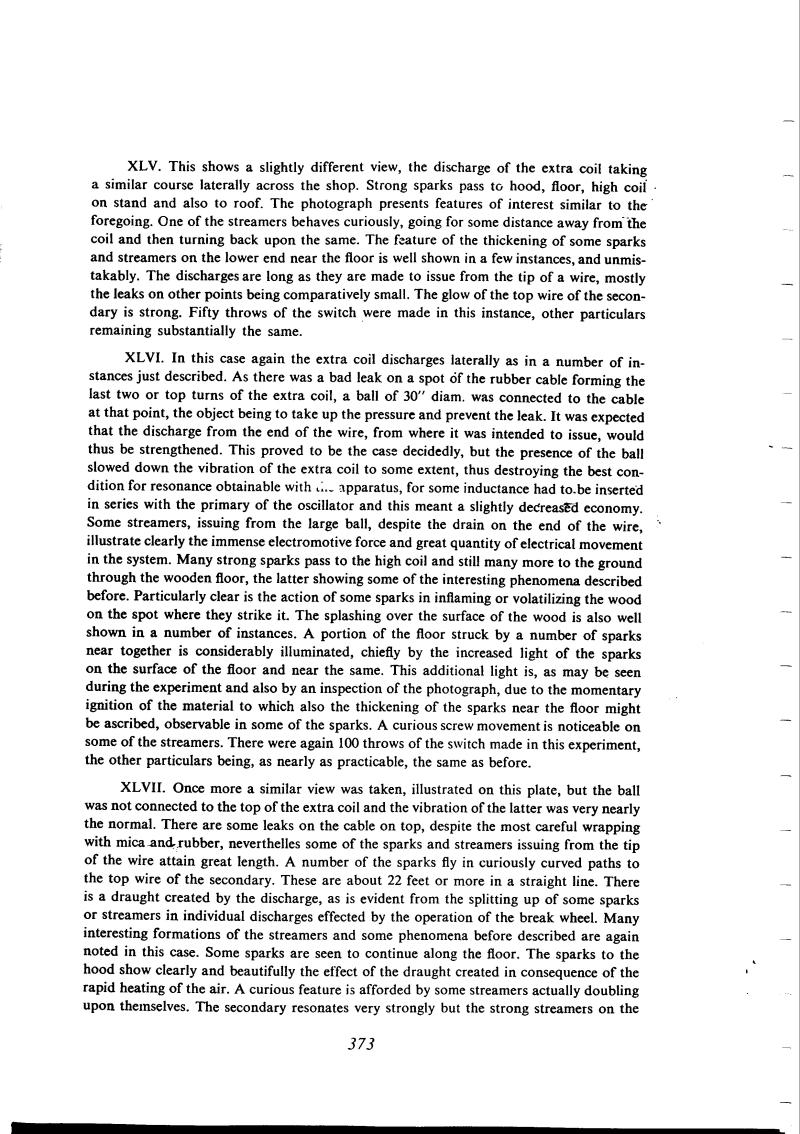
Nikola Tesla Books
XLV. This shows a slightly different view, the discharge of the extra coil taking a similar course laterally across the shop. Strong sparks pass to hood, floor, high coil on stand and also to roof. The photograph presents features of interest similar to the foregoing. One of the streamers behaves curiously, going for some distance away from the coil and then turning back upon the same. The feature of the thickening of some sparks and streamers on the lower end near the floor is well shown in a few instances, and unmistakably. The discharges are long as they are made to issue from the tip of a wire, mostly the leaks on other points being comparatively small. The glow of the top wire of the secondary is strong. Fifty throws of the switch were made in this instance, other particulars remaining substantially the same.
XLVI. In this case again the extra coil discharges laterally as in a number of instances just described. As there was a bad leak on a spot of the rubber cable forming the last two or top turns of the extra coil, a ball of 30" diam. was connected to the cable at that point, the object being to take up the pressure and prevent the leak. It was expected that the discharge from the end of the wire, from where it was intended to issue, would thus be strengthened. This proved to be the case decidedly, but the presence of the ball slowed down the vibration of the extra coil to some extent, thus destroying the best condition for resonance obtainable with the apparatus, for some inductance had to be inserted in series with the primary of the oscillator and this meant a slightly decreased economy. Some streamers, issuing from the large ball, despite the drain on the end of the wire, illustrate clearly the immense electromotive force and great quantity of electrical movement in the system. Many strong sparks pass to the high coil and still many more to the ground through the wooden floor, the latter showing some of the interesting phenomena described before. Particularly clear is the action of some sparks in inflaming or volatilizing the wood on the spot where they strike it. The splashing over the surface of the wood is also well shown in a number of instances. A portion of the floor struck by a number of sparks near together is considerably illuminated, chiefly by the increased light of the sparks on the surface of the floor and near the same. This additional light is, as may be seen during the experiment and also by an inspection of the photograph, due to the momentary ignition of the material to which also the thickening of the sparks near the floor might be ascribed, observable in some of the sparks. A curious screw movement is noticeable on some of the streamers. There were again 100 throws of the switch made in this experiment, the other particulars being, as nearly as practicable, the same as before.
XLVII. Once more a similar view was taken, illustrated on this plate, but the ball was not connected to the top of the extra coil and the vibration of the latter was very nearly the normal. There are some leaks on the cable on top, despite the most careful wrapping with mica and rubber, nevertheless some of the sparks and streamers issuing from the tip of the wire attain great length. A number of the sparks fly in curiously curved paths to the top wire of the secondary. These are about 22 feet or more in a straight line. There is a draught created by the discharge, as is evident from the splitting up of some sparks or streamers in individual discharges effected by the operation of the break wheel. Many interesting formations of the streamers and some phenomena before described are again noted in this case. Some sparks are seen to continue along the floor. The sparks to the hood show clearly and beautifully the effect of the draught created in consequence of the rapid heating of the air. A curious feature is afforded by some streamers actually doubling upon themselves. The secondary resonates very strongly but the strong streamers on the
373

